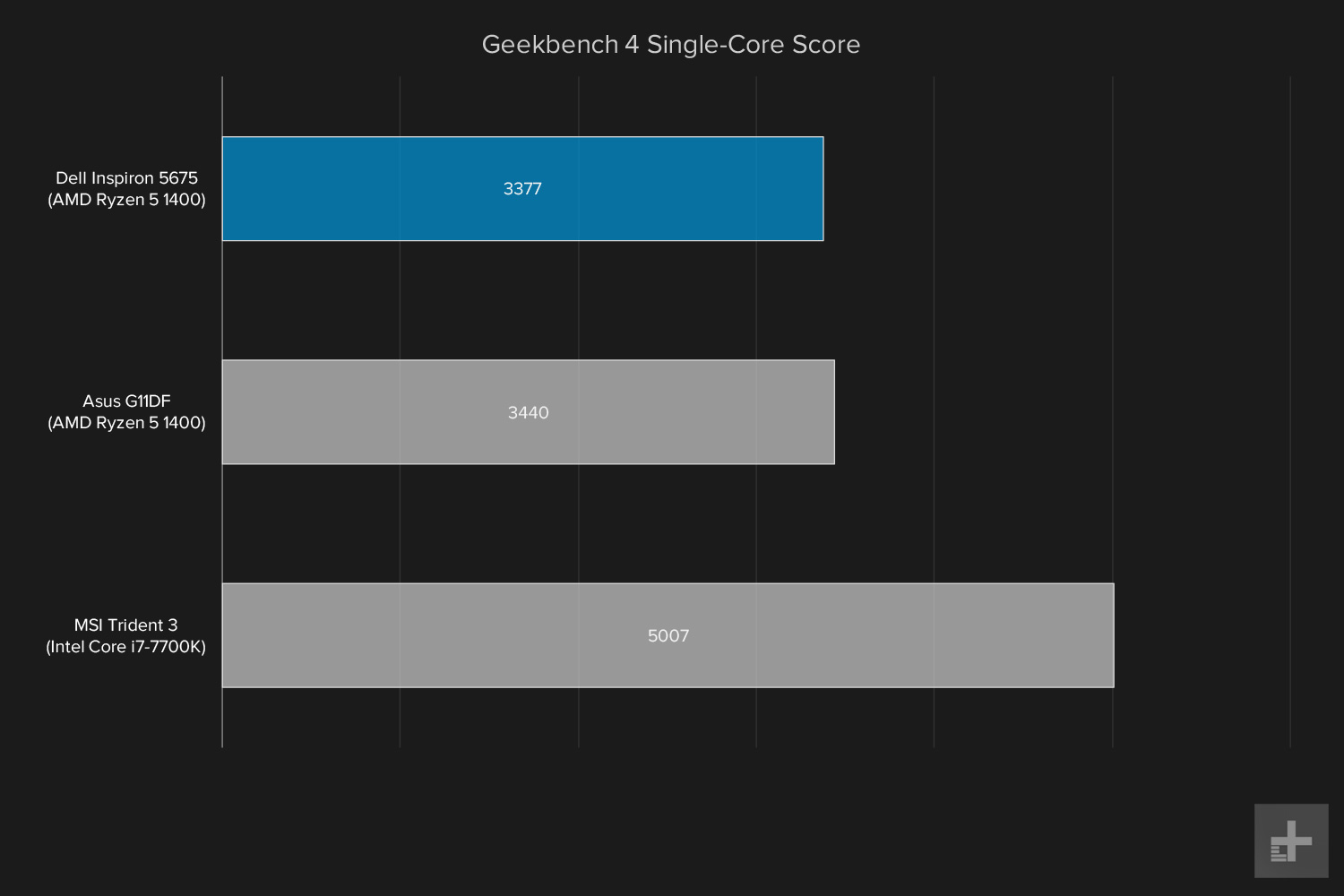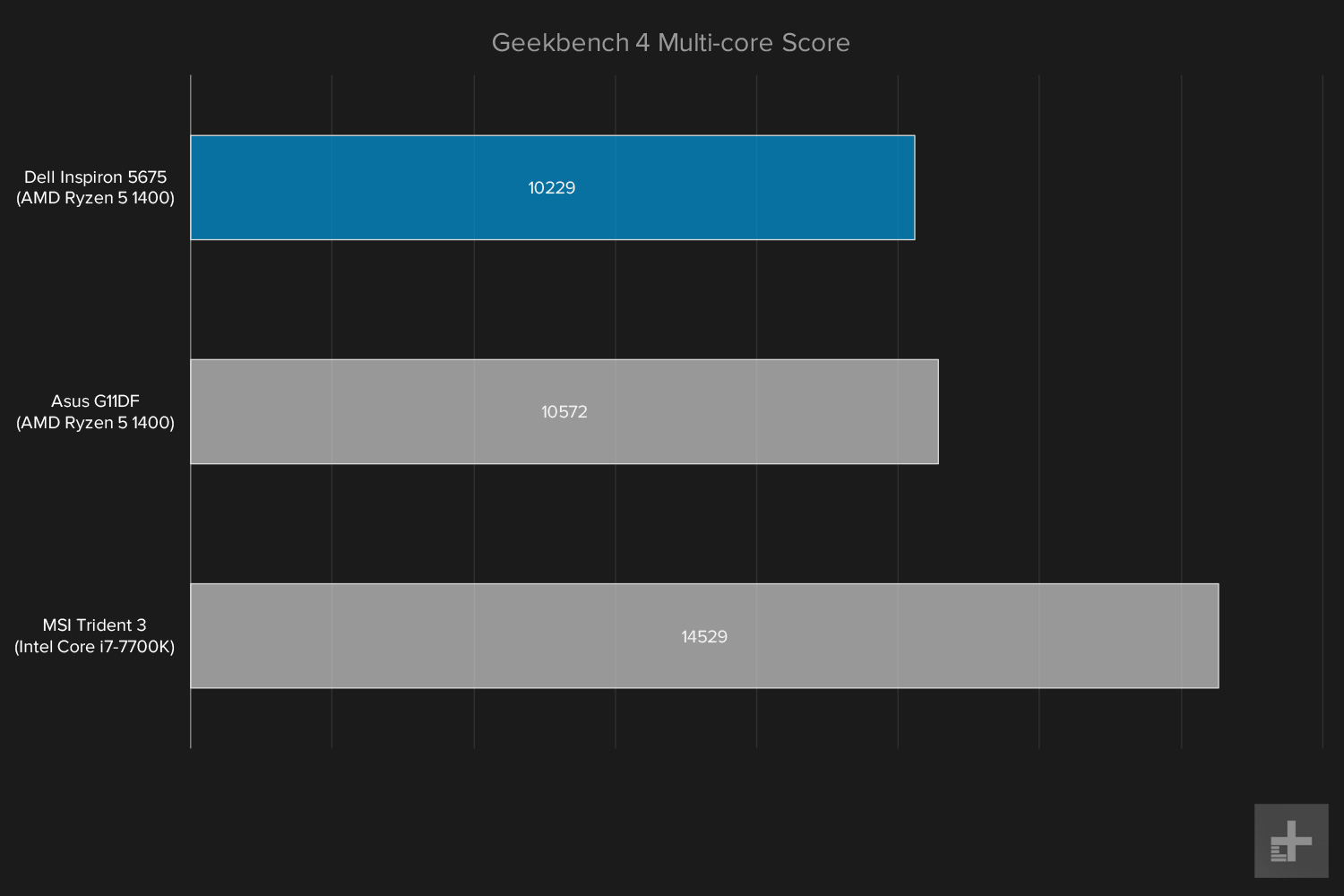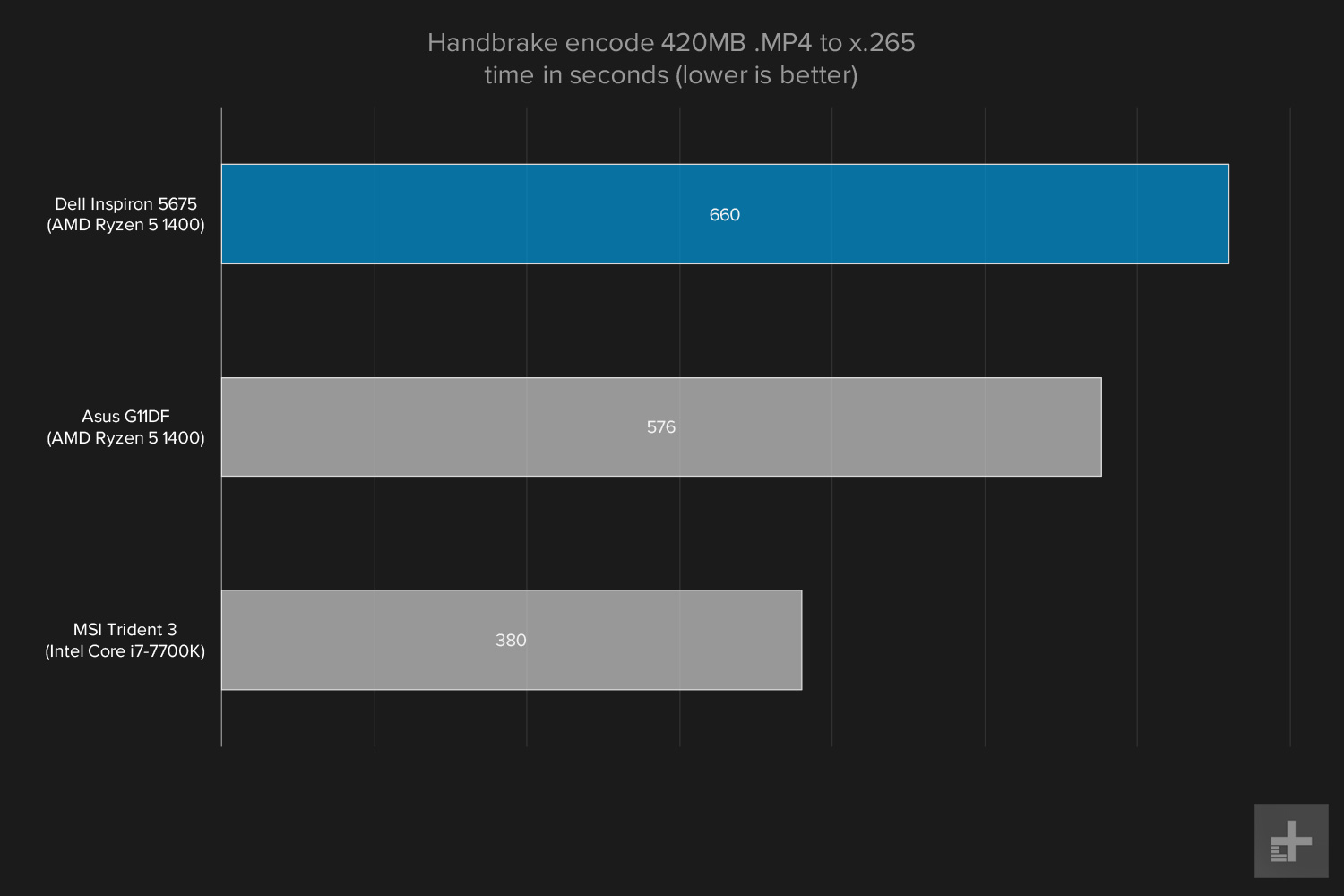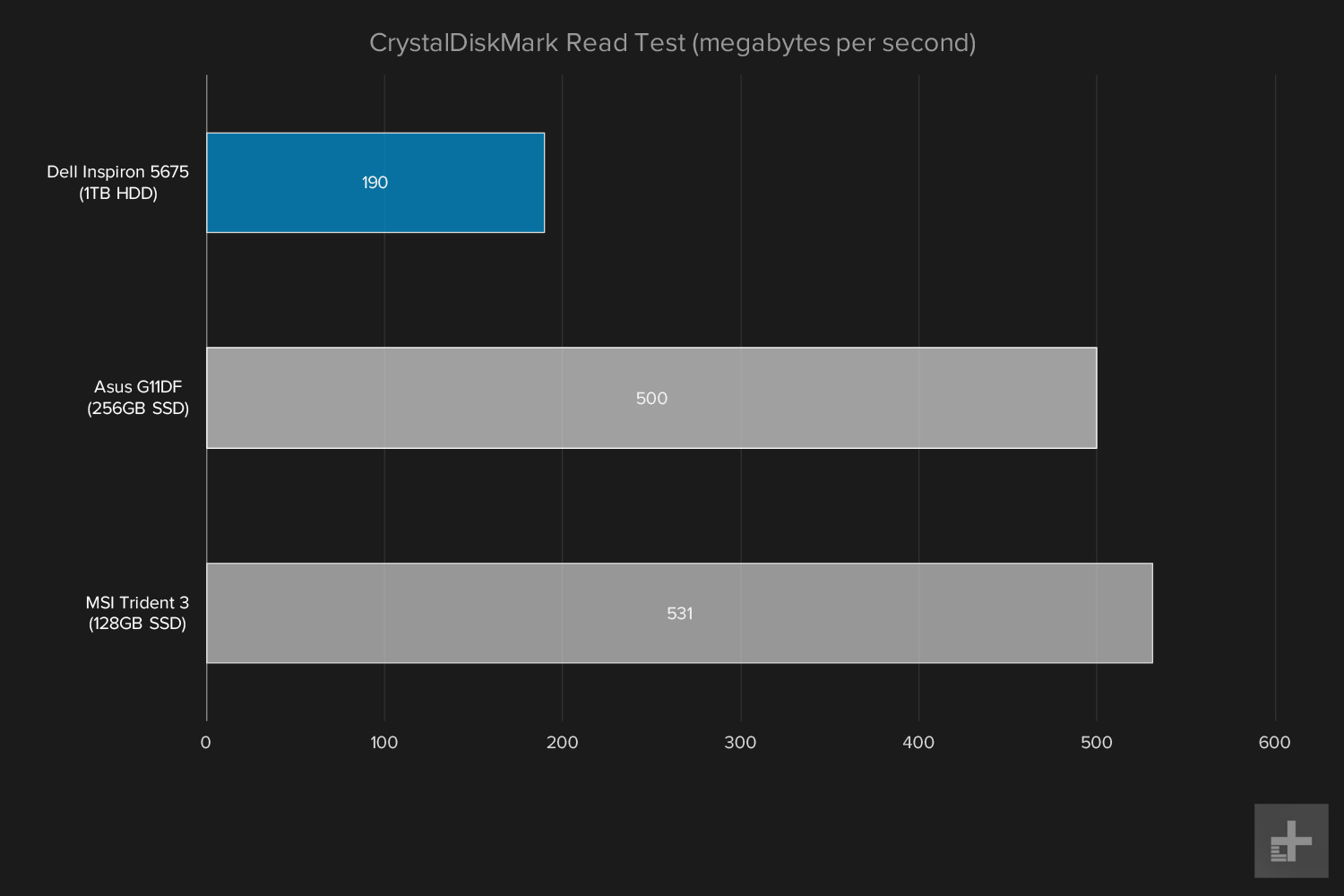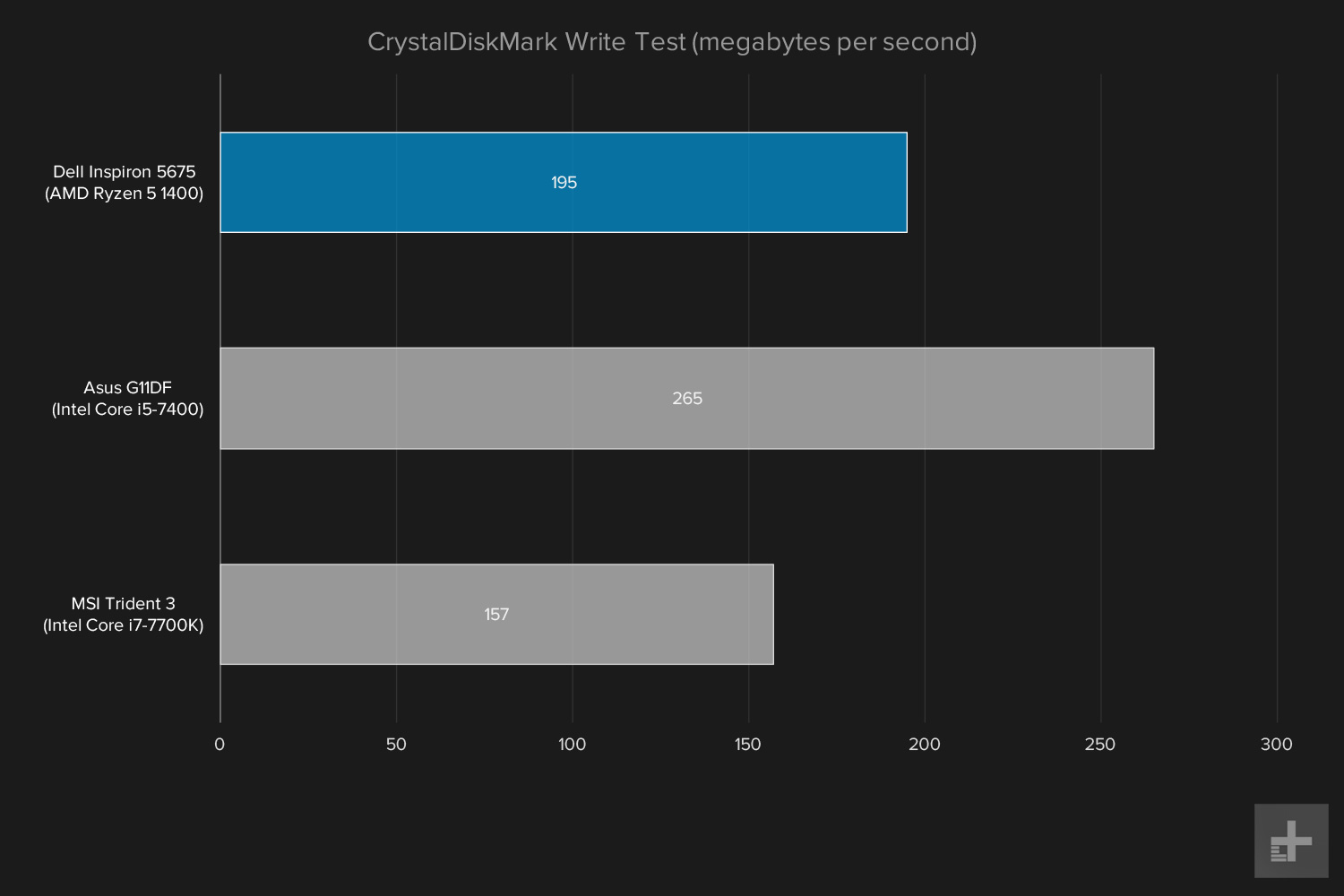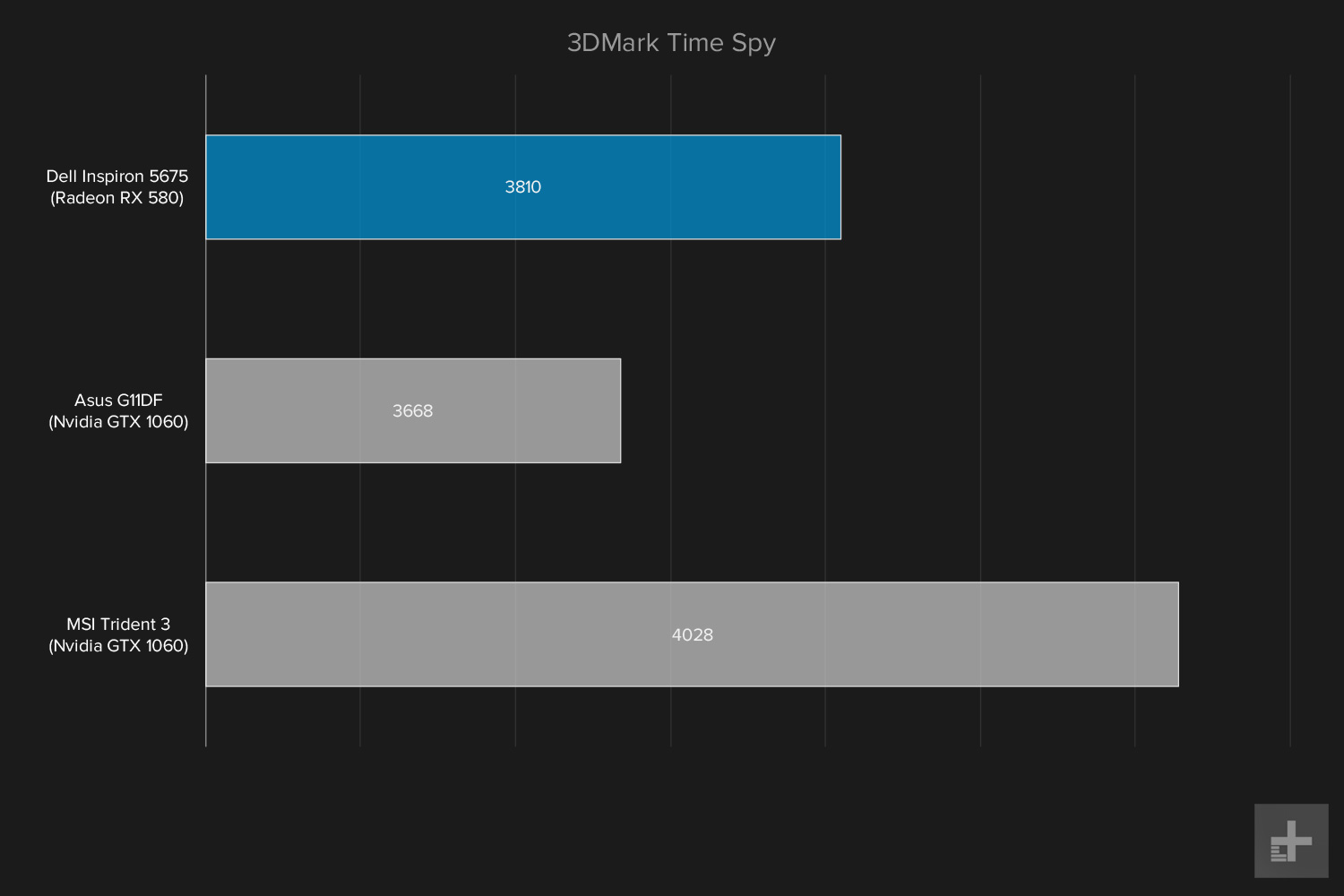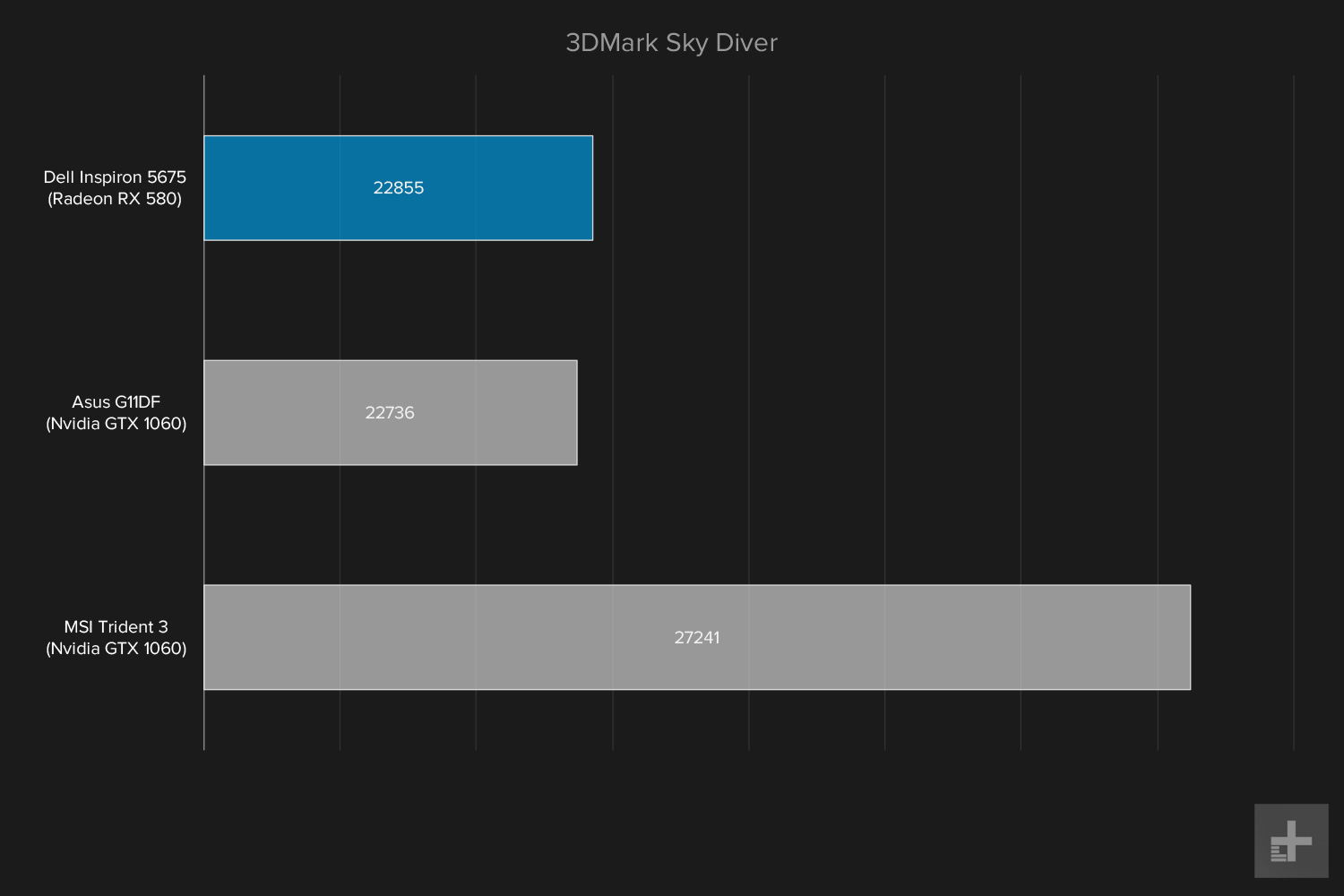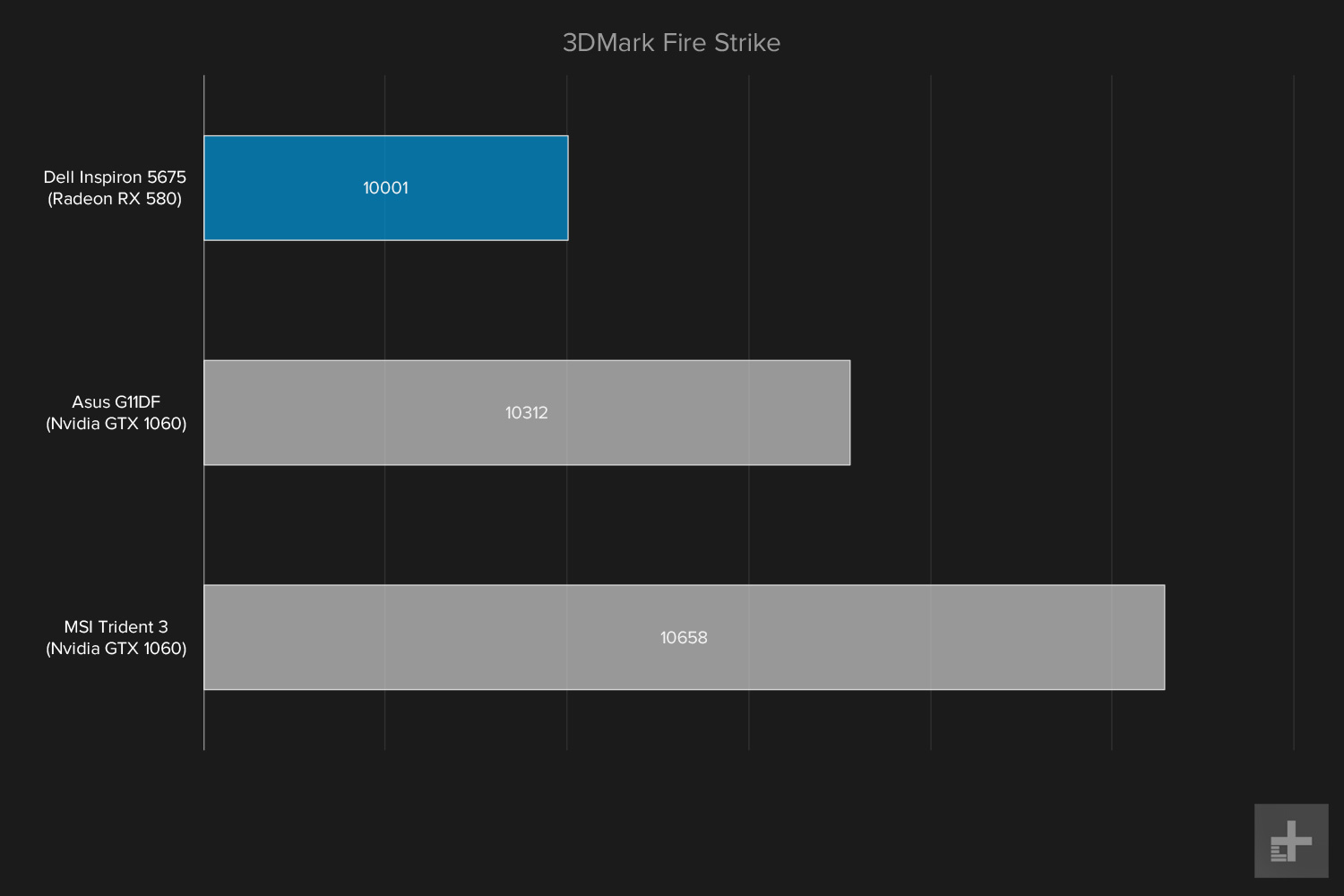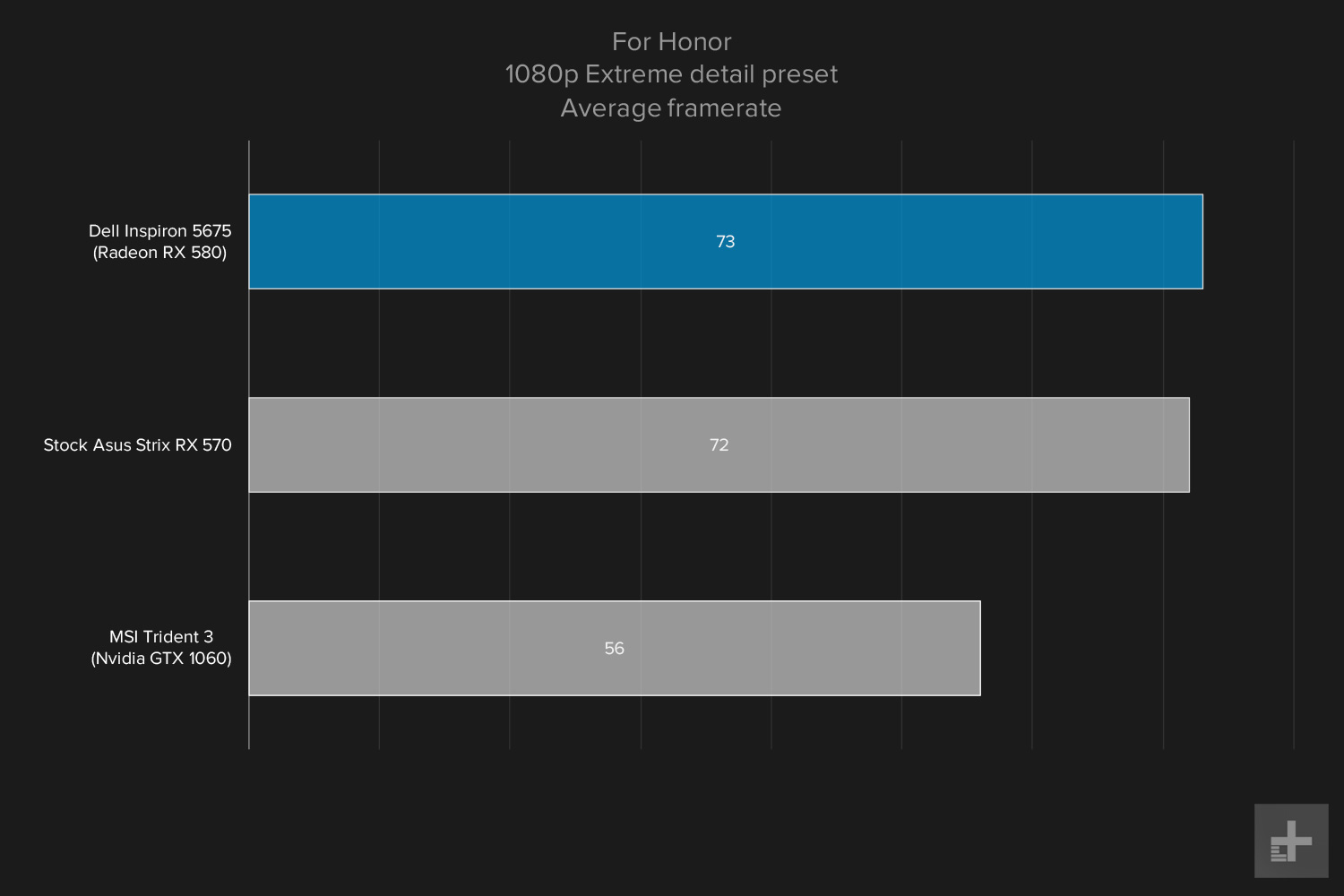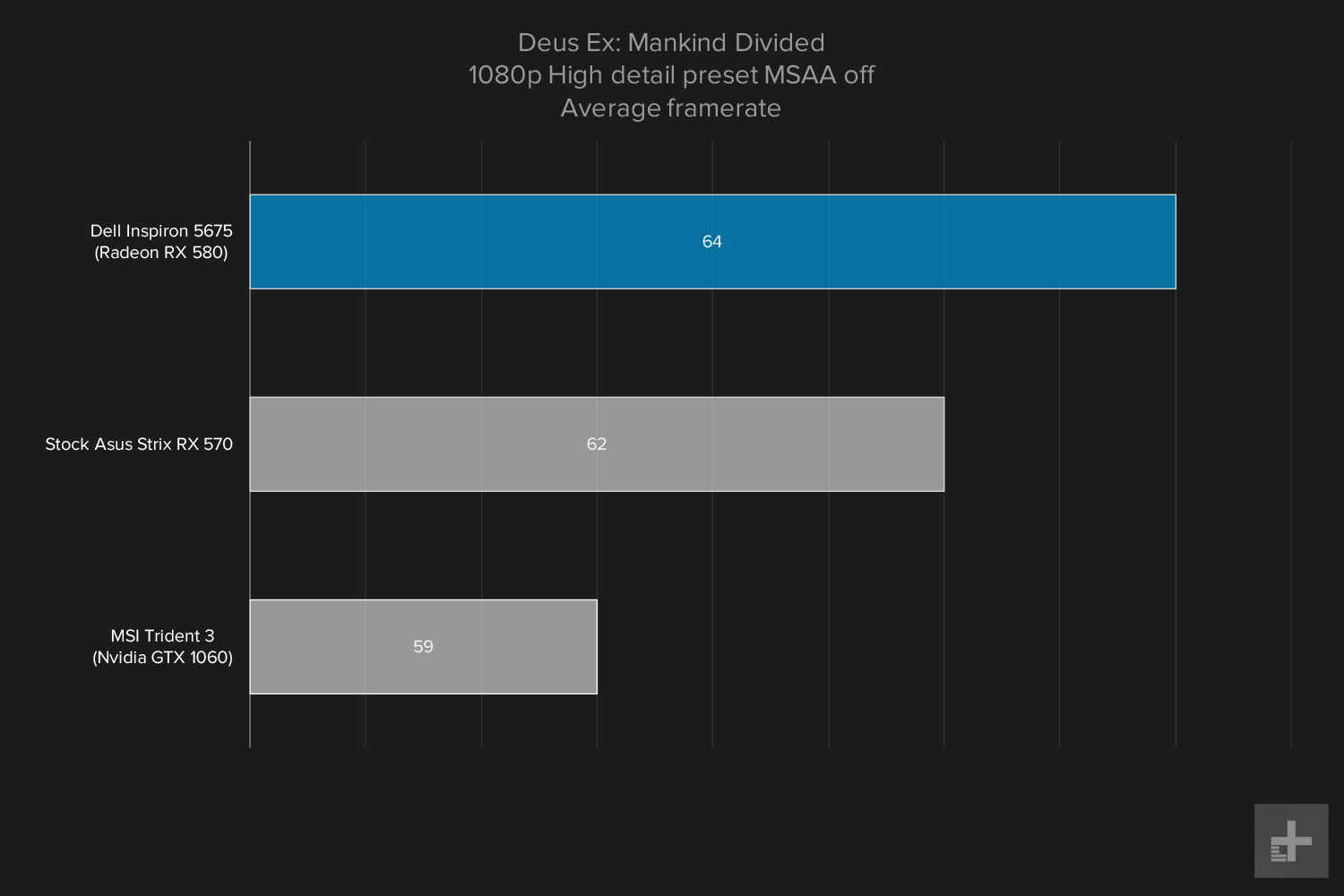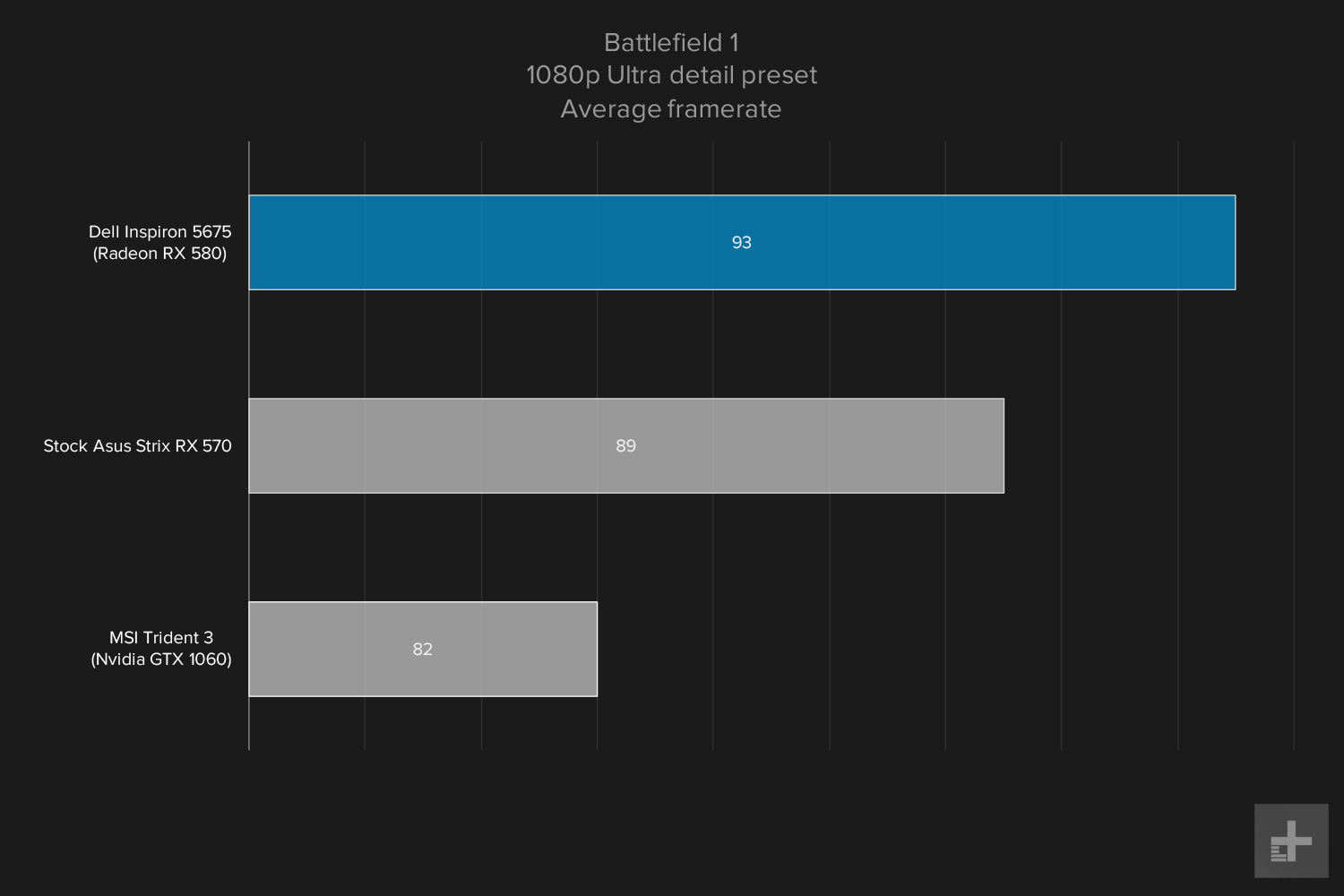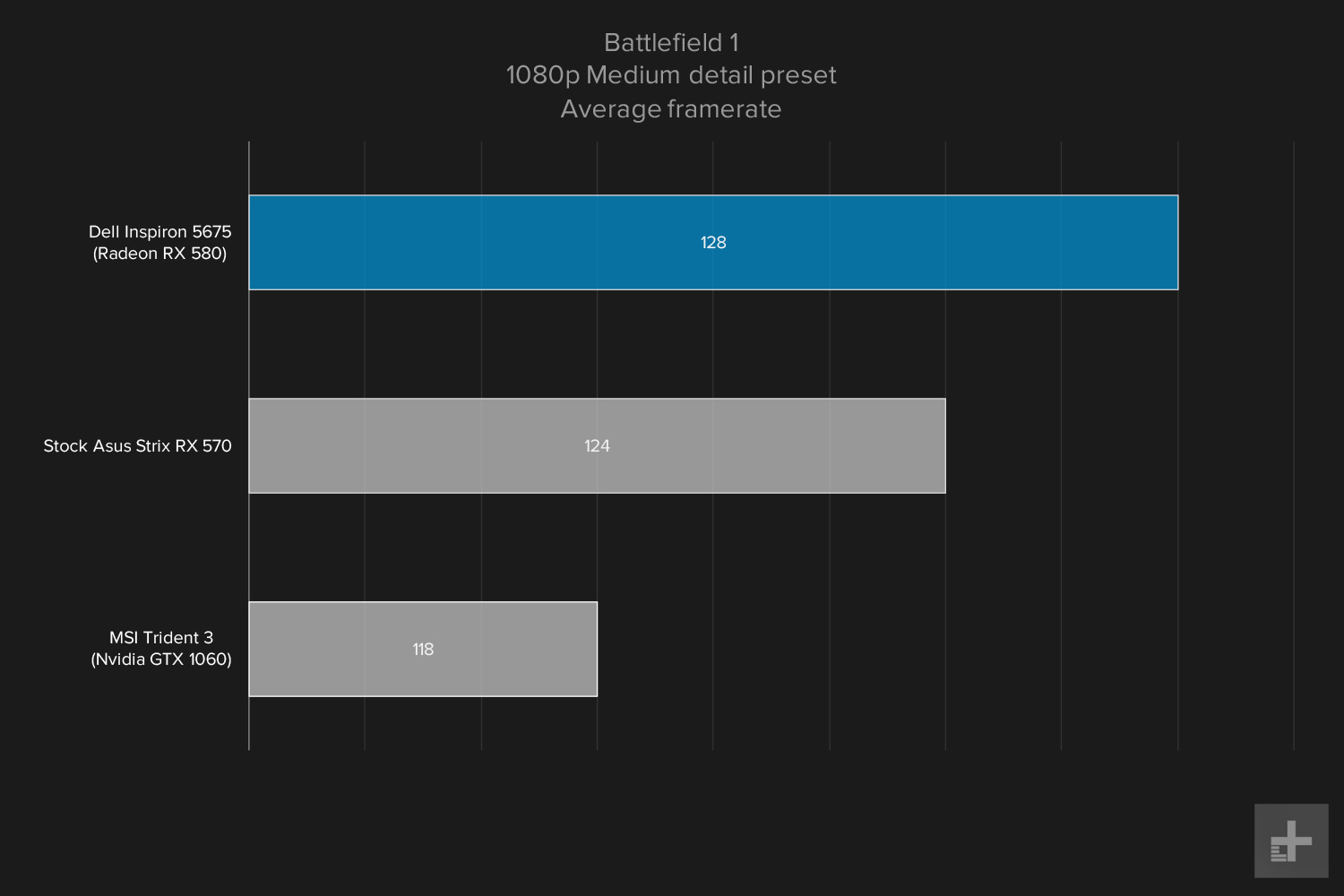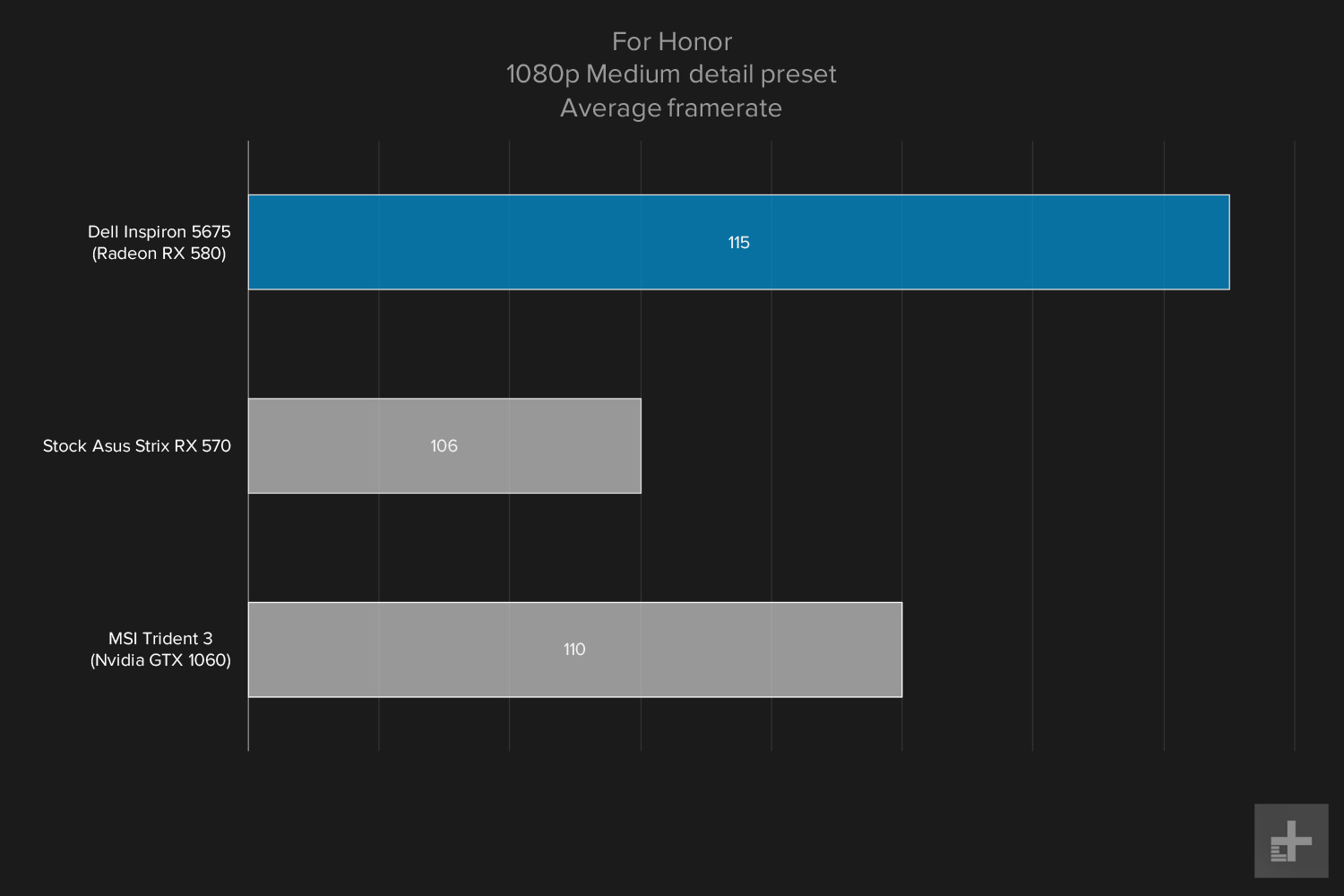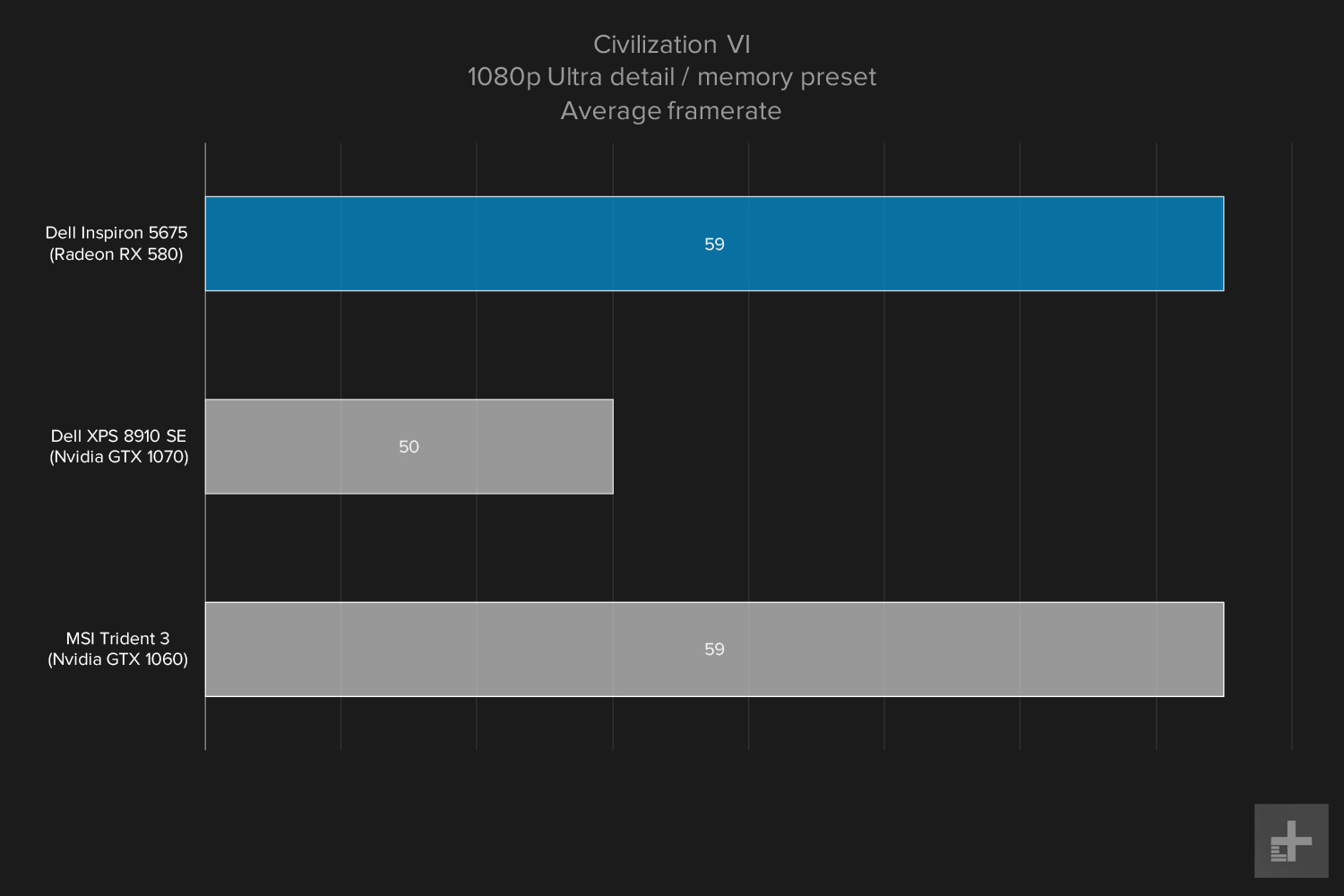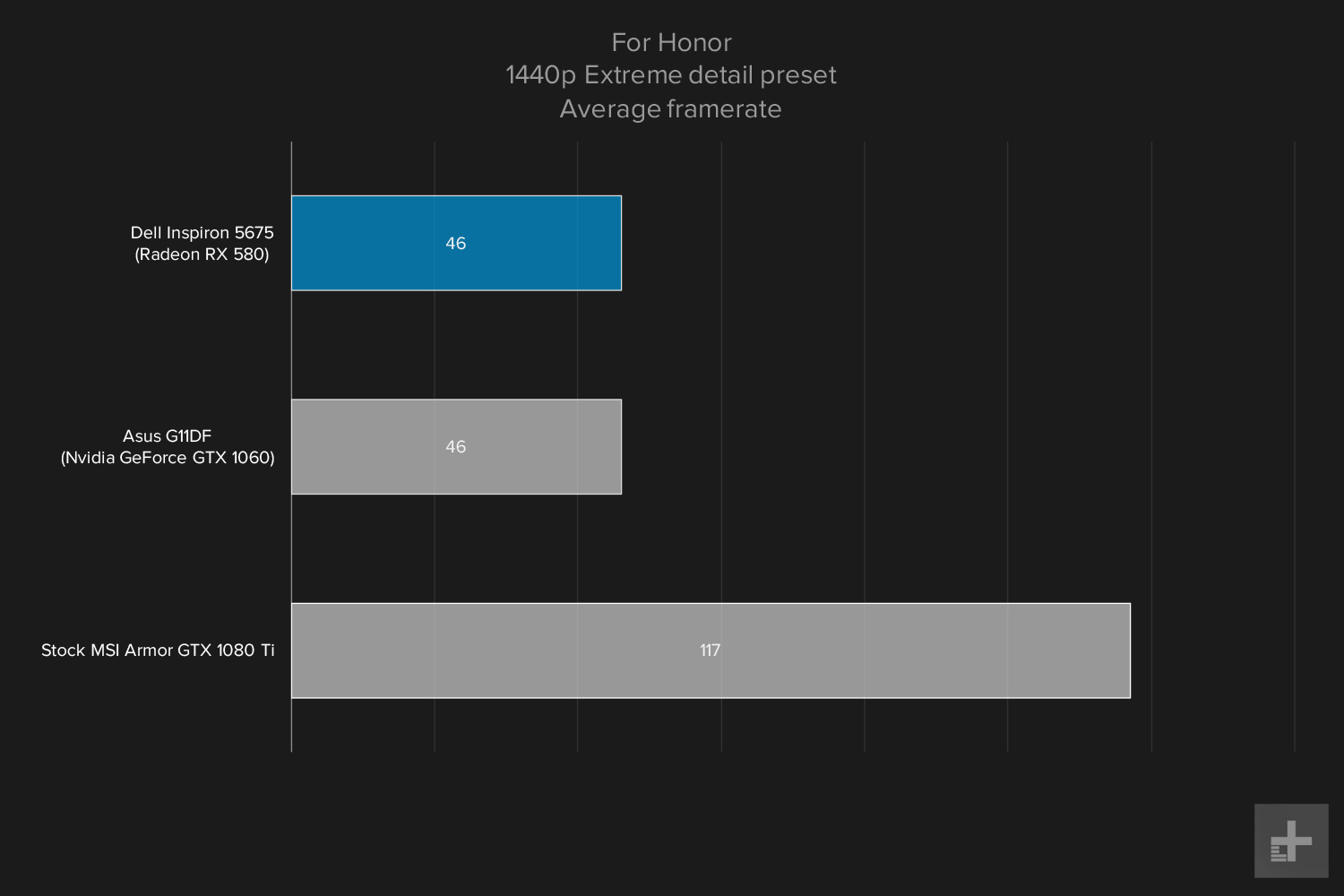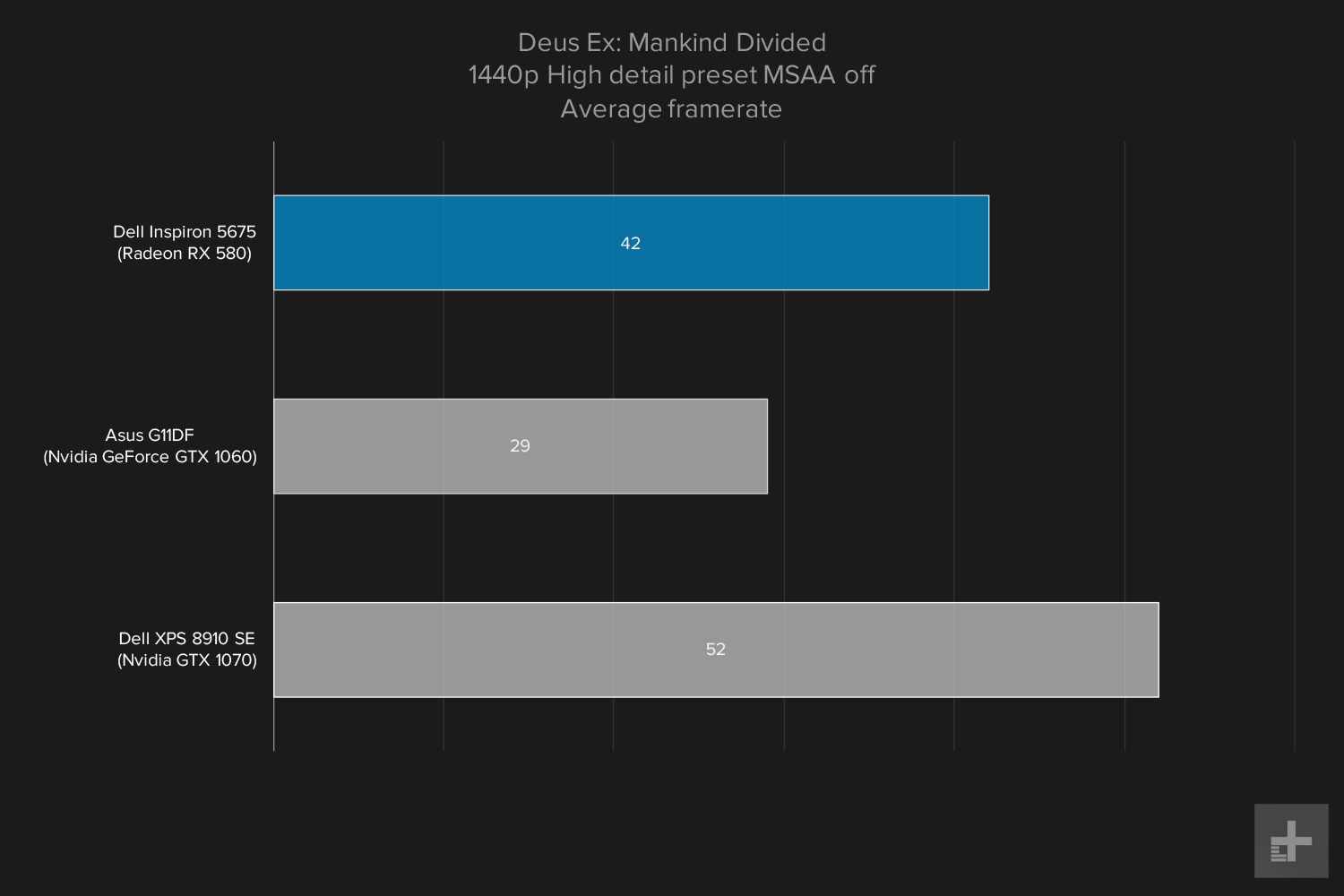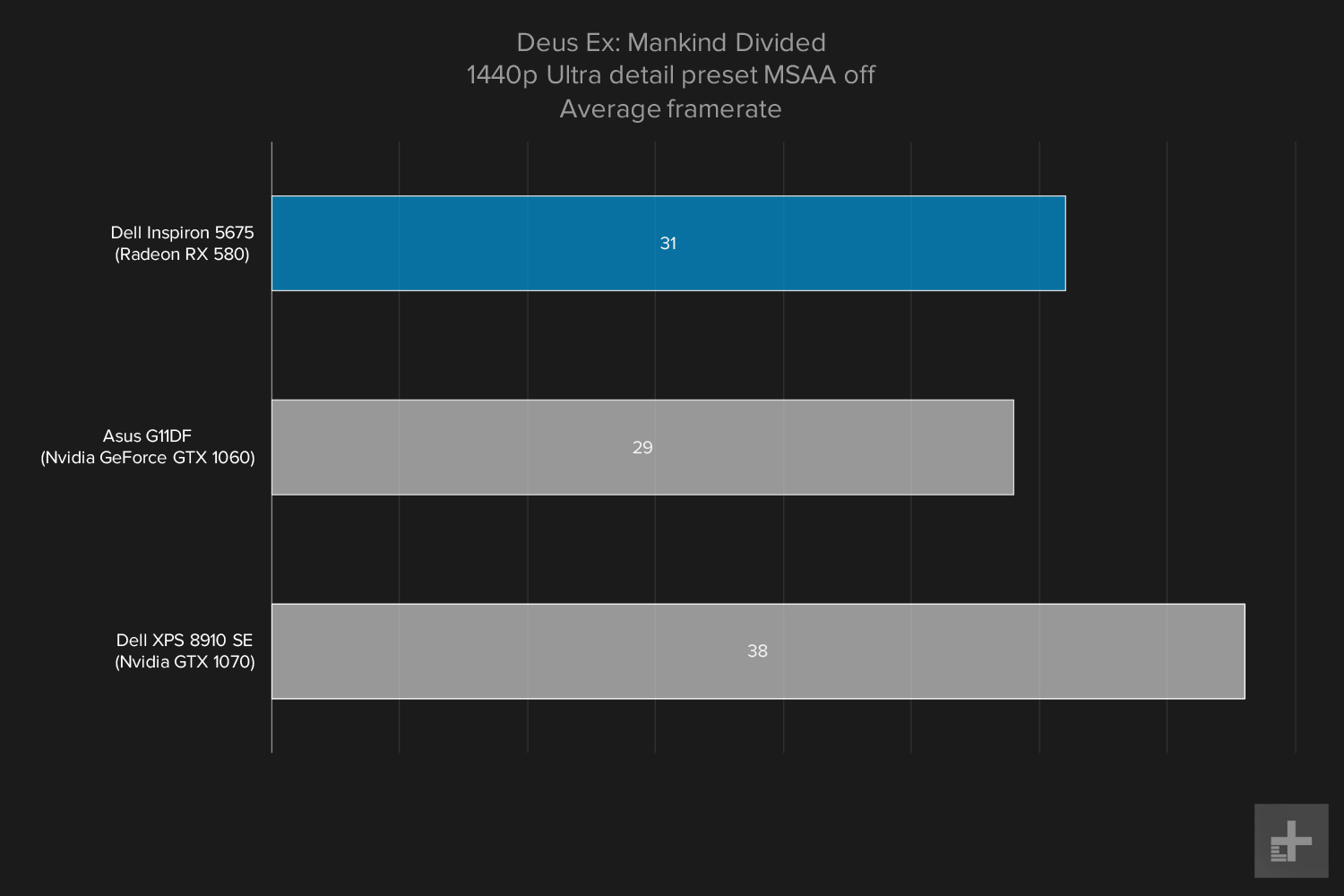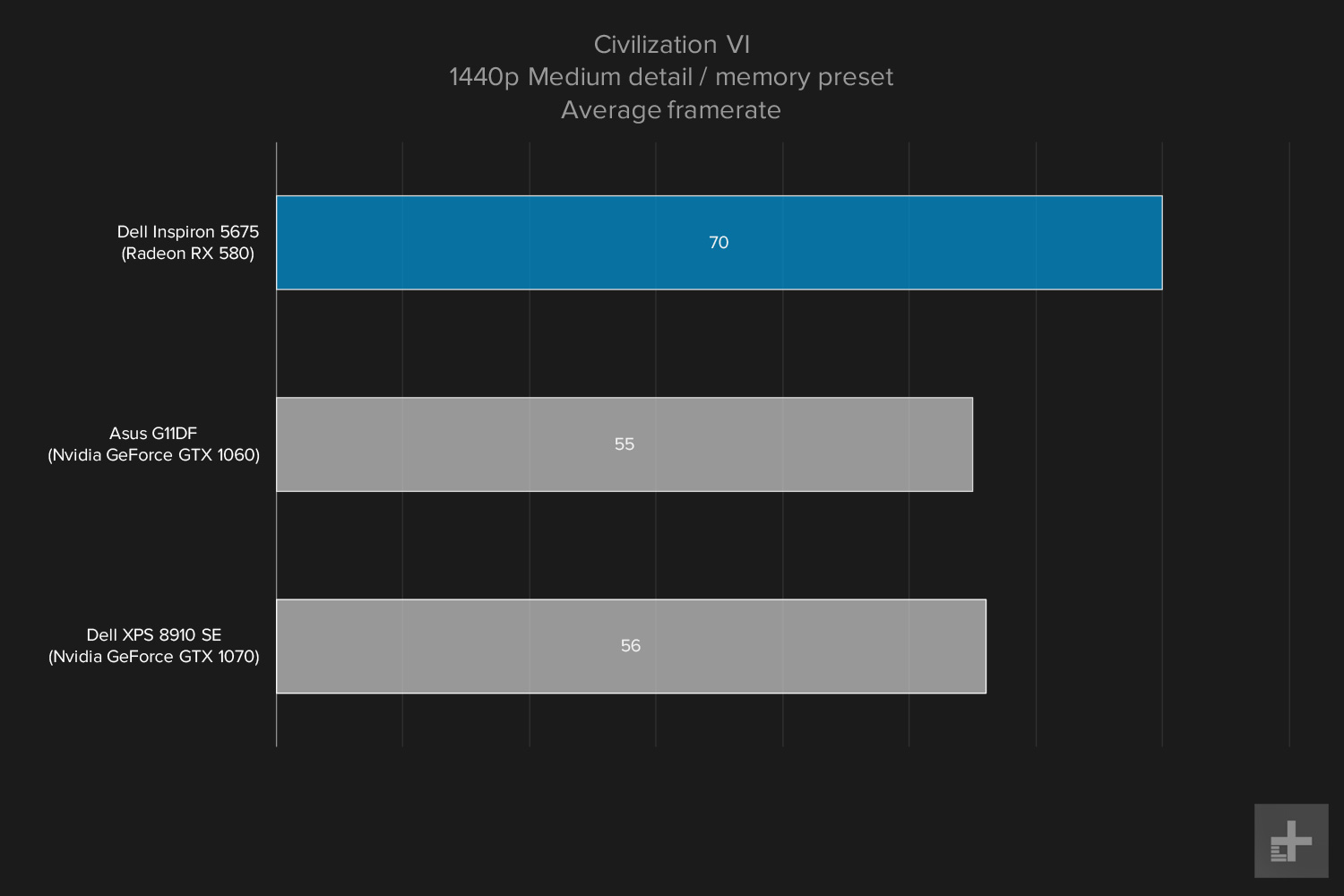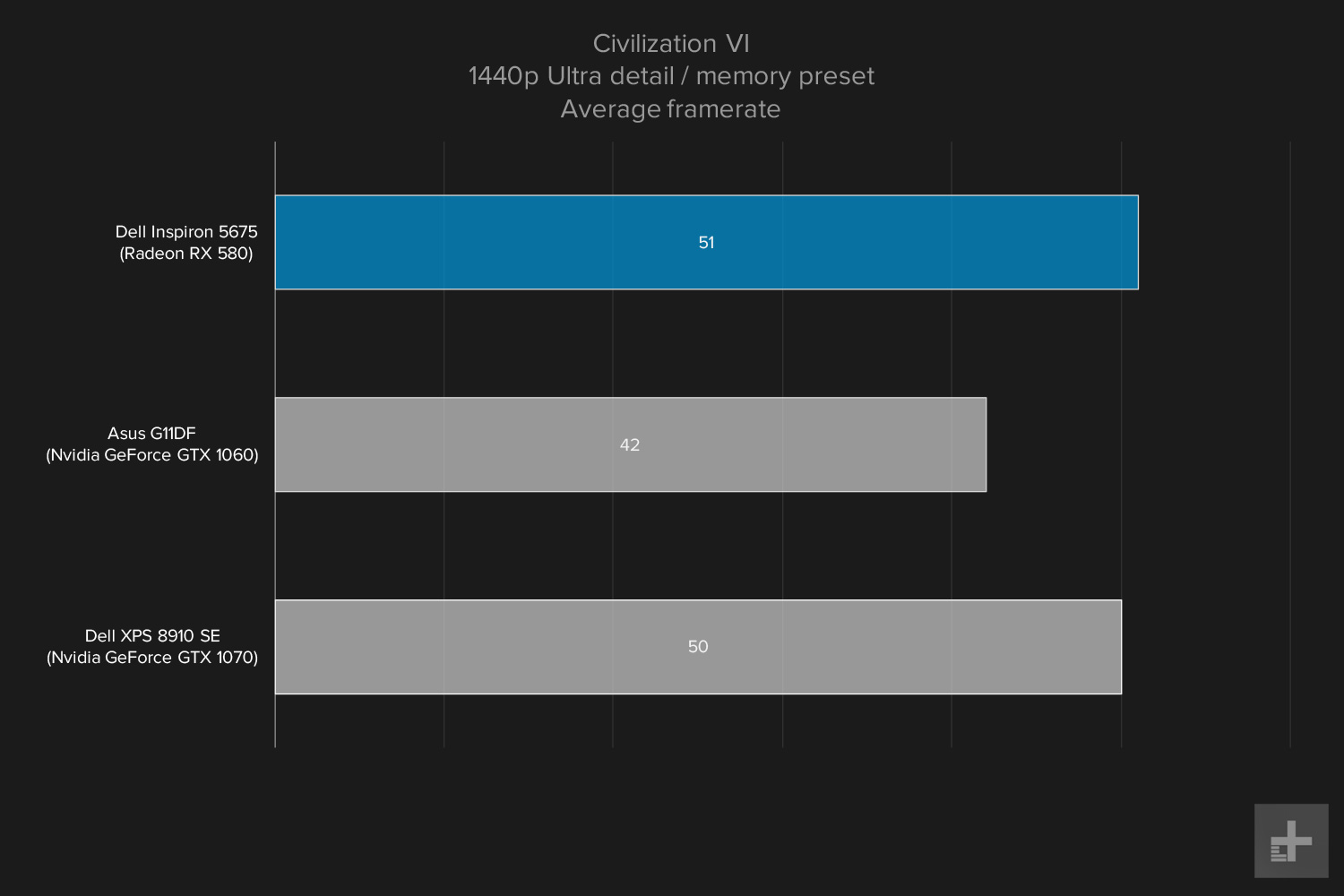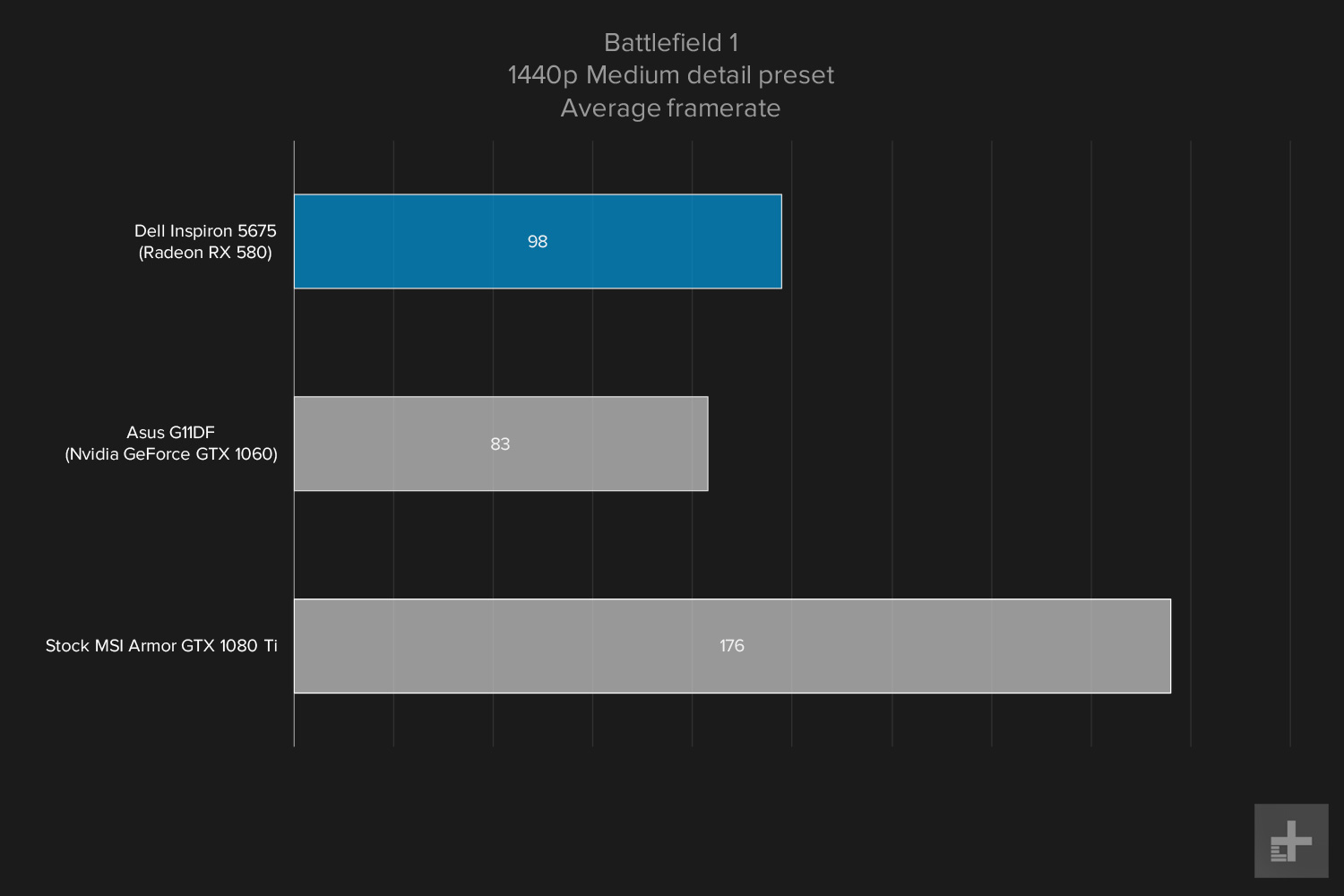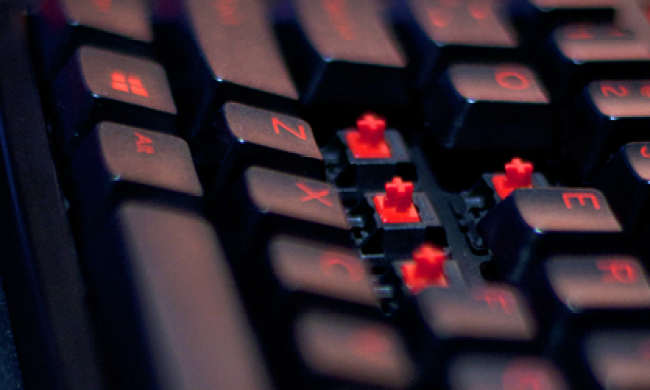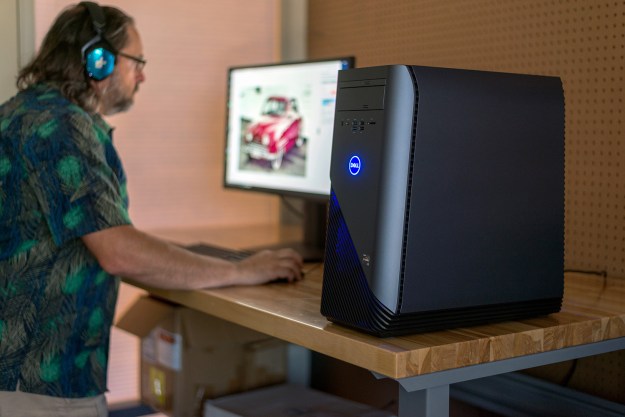
- Low price
- Ryzen brings solid multi-core performance
- Attractive exterior
- Easily handles games at 1080p
- Awkward internal design
- Not very futureproof
Investing in a gaming desktop can be an intimidating prospect, as there’s a lot of options out there, at a lot of different price points. Finding one with the speed and versatility to get the most out of the latest games is easy enough, if you don’t mind spending a fortune. It’s tougher to find a desktop that can do all those things for less than $1,000, but during our Dell Inspiron 5675 review, we came to realize that it just might fit the bill.
Our unit of the Inspiron 5675 featured an AMD Ryzen 5 1400 processor, 8GB of RAM, an AMD Radeon RX 580 graphics card, and a 1TB hard drive. Built with AMD’s latest hardware and clad in a stylish chassis, the Inspiron 5675 aims to offer solid, reliable gaming performance on a budget. Let’s see if it’s up to the task.
Custom quality
While the Dell Inspiron 5675 is no Alienware, it has a certain style to it. Dell has blended a streamlined, office-friendly sensibility with a few strokes of gaming audacity. The case is a standard metal column shrouded in a silvery plastic shell, accented with black angled vents which wrap around the case. The bright blue internal lighting seeps out of those vents, and looks great from every angle.
An internal grille gives the light a textured look, depending on your viewing angle. It’s not as elegant as a simple tempered glass side-panel, but it’s a dash of originality that’s nice to see in an affordable gaming desktop. One of the benefits of going with a custom build from a big company like Dell is that you can expect a certain degree of build quality, which is definitely evident here.
The Asus G11DF, a direct competitor to the Dell Inspiron 5675, features a very different aesthetic. It’s not quite as audacious as Asus’ ROG lineup usually is, but it features a glossy black design broken up with glowing red panels on the front and side of the case.
Where the Inspiron looks chic and a bit understated, the Asus G11DF looks like a more typical gaming PC. Unfortunately, it also looks like a budget gaming PC. Put the two desktops side by side and you’d never guess that the Asus G11DF and Dell Inspiron 5675 were the same price. The Inspiron looks like a more expensive machine even if it isn’t.
Port-land
Around the back-side of the Inspiron 5675, you’ll find a standard array of ports — six USB-A ports, an Ethernet port, five audio input/output jacks, an adorably quaint pair of PS/2 ports, and two HDMI and DisplayPorts on the video card. On the front-side of the PC there are four more USB-A ports, an SD Card reader, a headphone jack, and a single USB-C port.
That’s a lot of ports, and enough variety to ensure you’ll never have any trouble plugging in your devices or accessories — for now. While USB-A isn’t going anywhere soon, it would’ve been nice to see a few of those slots make way for a few additional USB-C ports, if only to make sure the Inspiron remains as future-proof as possible.
Keep your hands outside
A custom-built chassis, like the one on the Inspiron 5675, is designed to be a closed system, a product as static as a smartphone or game console. Sure, you can pop open the side by removing a couple screws — the side panel slides open easily enough — but once you’re in there, it’s hard not to feel unwelcome.
You can pop open the side, but once you’re in there it’s hard not to feel unwelcome.
All the internal components are right where they should be, and even if it is a little cramped, there’s some room for expansion — like an extra RAM slot. But the Radeon RX 580 video card is bolted in with a metal bracket which requires a fair amount of patience to remove. The bracket holds the card in place, and we’d wager it exists to prevent damage in shipping. We’ve encountered broken PCIe slots due to rough handling more than once in the past. However, the bracket is perfectly sized for the Radeon RX 580, and might not fit abnormally sized graphics cards. Upgrading to a different card might mean ditching the bracket.
The internal cable management is inelegant, but gets the job done. None of the internal components are obscured by cables, but they are threaded through the case haphazardly, like some kind of multi-colored weed growing inside the computer. It’s also worth mentioning that cooling was a bit of an afterthought here.
The case only includes two fans, an 80mm fan on the CPU’s cooling block, and a 92mm fan mounted on the case. Usually, we’ll see a pair of fans on the back of the case, one or two on the front, and a much taller or quicker air cooling fan on the CPU. What’s provided is sufficient for the hardware in the system, though again, doesn’t offer much room for expansion.
It’s not atypical for budget systems to be a little cramped and spartan inside. The Asus G11DF, for instance, also features limited cooling, and some internal brackets which keep hardware from moving around — and make it a pain to remove or upgrade components. At $950 though, there just aren’t very many PCs on the market that are going to offer the same kind of luxurious interior you’d get out of a more expensive gaming rig.
Internally, the lighting is provided by a single blue LED strip, which was missing a screw in our review model. When we opened the case, it just kind dangled in place. Once we figured out where it was supposed to be and fastened it in place with one of the many extraneous screws inside the Inspiron 5675’s case, it filled the case with an icy blue light. We don’t expect this to be a common issue, but it’d certainly annoy us if we’d purchased the desktop.
The Inspiron’s custom-built case is a best and worst-case scenario. While the exterior build quality is excellent, and the internal quality is robust, it’s not really designed for expansion. If you did upgrade the video card a year or two down the line, you might need to remove the bracket which, though probably not a functional issue, could be confusing.
Keeping up with Intel
Equipped with a mid-range quad-core Ryzen 5 1400 processor clocked at 3.2GHz, the Inspiron 5675 is a scrappy little machine. It’s not going to outrun its Intel competitors, but this little guy has heart — and a killer price tag. On its own the Ryzen 5 1400 retails for about $160, which makes it one of the least expensive modern quad-core processors on the market. It can even handle two processing threads per core, which means it’s able to handle eight threads at once. That’s a feature Intel quad-cores gain only once they hit the $300 mark, with the Core i7-7700 or 8700.
However, the price is only part of the equation here. Let’s see how well the Ryzen 5 1400 performs in everyday use.
On Geekbench, we can see where the Ryzen 5 1400 scores in relation to similar processors. With a score of 3,377 on single-core performance, it lands just ahead of the Asus G11DF’s own Ryzen 5 1400, which hit 3,440. Both are quite a bit behind the top-end Intel Core i7-7700K, which managed an impressive score of 5,007.
Multi-core performance was a similar story, with the AMD chips coming tied for second behind the Intel chip. That’s not too much of a surprise, since comparable Intel processors usually outclass their AMD counterparts, offering better performance in exchange for higher prices. The important thing to note here is the margin of the Intel chip’s victory. While it is well ahead of the Ryzen 5 1400, it’s not so far ahead that you’d notice the performance gap for gaming, which isn’t typically very CPU intensive.
This little guy has heart — and a killer price tag.
When you factor in price and performance, AMD’s new Ryzen chips are catching up to some of Intel’s star performers. We can see these margins played out in our Handbrake tests as well. The Dell’s Ryzen 5 1400 is the slowest of the bunch, finishing the encode in 11 minutes. The Asus G11DF’s Ryzen 5, on the other hand, completed the encode in a little over 9 minutes 30 seconds. Either way, that’s a win for AMD.
So clearly, the Inspiron is a little behind its competitors – but not by much, and that’s important in a gaming machine. Why? Because your processor doesn’t play a significant role in graphical performance. Picking up a capable yet inexpensive processor is often the best route, and the Ryzen 5 1400 offers decent, reliable performance at a bargain-basement price. If you are more interested in getting an Intel-powered desktop, Dell now offers a Core i7 8700 version for $1,000.
The hard drive comes to a halt
Another way manufacturers can keep costs down is by opting for slower, cheaper hard drives like the one inside the Inspiron 5675. While it features a luxuriously large 1TB of space, it is remarkably slow.
During our tests, even moving large files around was a chore which took a bit longer than it should have. Given the results of our benchmarks, it’s easy to see why that was the case.
On our CrystalDiskMark tests, the Inspiron 5675 and its 1TB hard drive scraped by with a read speed of 190 megabytes per second, and a write speed of 195MB/s. Looking at a few similarly priced competitors, like the XPS 8910 SE and MSI Trident 3, that’s not too bad. Both of those systems have hard drives like the Inspiron. But if you compare the Inspiron’s hard drive to even a modest-performing PCIe SSD, the difference is clear.
Our review unit of the Acer Predator G1 featured a 512GB PCIe SSD capable of hitting a 530MB/s read speed and a 448MB/s write speed, far surpassing the Inspiron’s modest read and write speeds. Granted, our Predator G1 review unit was a $2,200 desktop. However, its higher price tag wasn’t because of its modest SSD, and including a slightly quicker drive in the Inspiron wouldn’t have inflated its price by much.
Even the Asus G11DF features a 256GB SSD with a read speed of 500MB/s and a write speed of 260MB/s, greatly eclipsing those of the Inspiron.
Luckily, you can upgrade the Dell Inspiron Gaming Desktop with a 256GB drive, which comes in addition to the 1TB mechanical disk, for only $100. We highly recommend it, as it will eliminate our complaints about hard drive performance.
Quicker than expected
One of the ways Dell was able to keep the Inspiron 5675’s price under $1,000 was by going with one of AMD’s latest graphics cards, the Radeon RX 580, instead of a pricier Nvidia option. The graphics card is the most influential part of your gaming experience, so let’s see how the RX 580 fares against the competition.
Here’s where things get interesting. Looking at these 3DMark scores, the RX 580 is neck-and-neck with two different systems both running Nvidia GeForce GTX 1060 graphics cards — which typically retail for around $200. The RX 580 should retail for about the same price, but current market forces — Bitcoin miners — have pushed prices up to around $500 in some cases. It’s hard to snag an RX 580 by itself right now, to the dismay of anyone looking to build their own budget PC.
Throughout our tests, the RX 580 was hot on the GTX 1060’s heels, pushing ahead in a few benchmarks. Looking at Time Spy, the Dell Inspiron 5675 and its RX 580 scored 3,810, to the Asus G11DF’s 3,668.
The GTX 1060 in the MSI Trident 3 fared a bit better with a score of 4,028, but that’s a very slim margin, and it illustrates that variances in hardware manufacturing can have an effect on performance. Even though the Asus G11DF’s GTX 1060 didn’t perform as well as the MSI’s, both were within striking distance of the RX 580.
But that’s just one benchmark. Let’s see if the RX 580 can keep up in actual games.
Once we started really putting the Inspiron 5675 and its RX 580 to the test, a few trends emerged. First, it’s clear that the RX 580 is a very capable card, but more than that, some games prefer it. There were a few games in our test suite that squeezed the most out of the RX 580, and pushed it passed the GTX 1060.
At ultra-high settings, the RX 580 managed 93 FPS in Battlefield 1, to the GTX 1060’s 82 FPS. In Deus Ex: Mankind Divided, the RX 580 surpassed the GTX 1060 by a surprising margin, with an average of 46 FPS on ultra-high graphics settings. The MSI Trident and its GTX 1060 only managed 38 FPS at the same settings, while the Asus G11DF hit 41 FPS. That’s a difference you can feel in actual gameplay.
In For Honor, we see the Inspiron and its RX 580 hit 73 FPS on the Extreme graphics preset, gaining ground on the MSI Trident and its GTX 1060, which topped out at 56 FPS. The Asus G11DF fared a bit better, with an average framerate of 73 FPS, putting it right on par with the RX 580. It should be noted that you can now configure the Inspiron Gaming desktop with the GTX 1060 for the same price.
Let’s see how the RX 580 fares at 1440p.
Gaming at 1440p is still a bit of a luxury, and if the Dell Inspiron 5675 barely managed to chug along at such a high resolution, it wouldn’t be surprising. It’s a budget gaming rig after all, so 1440p might be asking too much of the poor little guy. Yet the Dell Inspiron exceeded our expectations, decent framerates. We think 1080p is the better match for this system, but 1440p isn’t out of reach, depending on the games you prefer to play.
In Battlefield 1, the Inspiron and its RX 580 never dipped below 60 FPS at 1440p, even at ultra-high detail settings. That’s not bad for a $950 gaming rig. Deus Ex presented more of a challenge, dropping down to 42 FPS at High settings, and 31 FPS at Ultra.
For Honor was a stumbling block for the Inspiron at 1440p.
Running through the rain-slick streets of Prague in Deus Ex, at 1440p with the graphics settings turned up, wasn’t as smooth as it could have been. It looked a bit choppy here and there, especially during gunfights, but even with most settings maxed out, we could maintain a playable framerate by tweaking the graphics settings a little. It was an acceptable experience, at least on par with console versions of the title.
For Honor was a stumbling block for the Inspiron at 1440p, however. The RX 580 just couldn’t maintain the 60 FPS required for online play with all the settings maxed. At Extreme detail settings, it hit 46 FPS, and at high it managed 58 FPS. Medium settings offered some refuge, and the Inspiron reliably hit 68 FPS with settings toned down, even at 1440p.
Peripherals included, but you won’t want to use them
Dell ships the Inspiron 5675 with a mouse and keyboard, so you’ll be able to get up and running even if you only have a monitor. It’s nice for just getting it going right out of the box, but neither the keyboard nor mouse included are of very high quality.
The optical mouse is cheap hollow plastic with a flimsy cord, and the keyboard is oddly squishy for a desktop keyboard. Neither device is a pleasure to use, but they’ll see you through some light web browsing before they start to grate on your nerves.
Peripherals are always tricky territory for gaming rigs. Most gamers prefer to use their own hardware, and Dell seems to be counting on that here. The included devices are fine for getting the system up and running, but serious gamers will want to spend a little extra on better inputs.
Don’t worry about bloat
To be honest, there was always something satisfying about taking a scalpel and cauterizing torch to factory-fresh PCs laden with bloatware. The Dell Inspiron 5675 ships pleasantly light, with only a few branded — and useful — utilities for maintaining the machine. There’s no need to dig into the registry to carefully excise every last bit of unwanted bloatware.
If you absolutely must purge every last bit of branded freeware from your system, a quick trip through the Add/Remove Programs menu can easily slim things down further.
Warranty information
The Dell Inspiron 5675 ships with a one-year limited hardware warranty protecting against any manufacturer defects, and it includes one year of mail-in service for any defects in materials or workmanship. That’s not very long, but it’s on par with what you’d get from other manufacturers at the price point.
Our Take
The Dell Inspiron 5675 is a solid performer with a few drawbacks, but its low price and solid gaming performance make it a good choice, especially if you’re looking to step into the world of PC gaming for the first time.
Is there a better alternative?
There are a fair number of options available to you at less than $1,000. Each major manufacturer has at least one desktop around that price, but finding one with hardware comparable to the Dell Inspiron 5675 is tough without crossing that price threshold. There’s an even an Intel-based version now available, which features a Core i3-8100 CPU and an Nvidia GeForce GTX 1060 with 3GB for just $750.
Acer, for instance, offers the Aspire GX-785-UR16, an Intel-based gaming desktop for around $900. It features an AMD Radeon RX 480 graphics card, which is a step down from the RX 580 in the Dell Inspiron 5675. The difference in price between the two machines is almost negligible, and the Inspiron’s superior graphical performance is definitely worth an extra $50.
Asus, on the other hand, offers the G11DF Gaming Desktop for nearly the same price as the Inspiron 5675, it retails for $1,000, depending on configuration. Featuring a Ryzen 5 1400 CPU, and an Nvidia GeForce GTX 1060 GPU, it’s a worthy competitor to the Inspiron, so if you’d prefer to go with AMD and Nvidia instead of just AMD, it wouldn’t be a bad choice.
If you’re looking for something a bit more subtle in terms of casing, it’s worth checking out the Dell XPS 8930 Tower. It’s not marketed or designed as a gaming desktop, but it features a GTX 1060 6GB for just $1,000.
Overall, there are many alternatives for cheap gaming PCs to the Dell Inspiron 5675, but none are hands-down better for the price. The Dell gets a leg up due to its balance of price and performance.
How long will it last?
This is a tough question for the Inspiron 5675. It’s well-built, and it’s unlikely to fall apart after a few years on the job. However, its components aren’t quick enough to keep up with PC gaming trends for more than a couple years without serious compromise. Turning down your settings, sticking to 1080p, the Inspiron 5675 will probably last a few years, but by the time Destiny 3 rolls around, it’s going to be time for a new PC.
Should you buy it?
If you’re new to PC gaming, or you’re looking to get back into it, the Dell Inspiron 5675 is a great choice. It’s not going to break the bank, and it’ll see you through at least a few major PC game release cycles in style.







